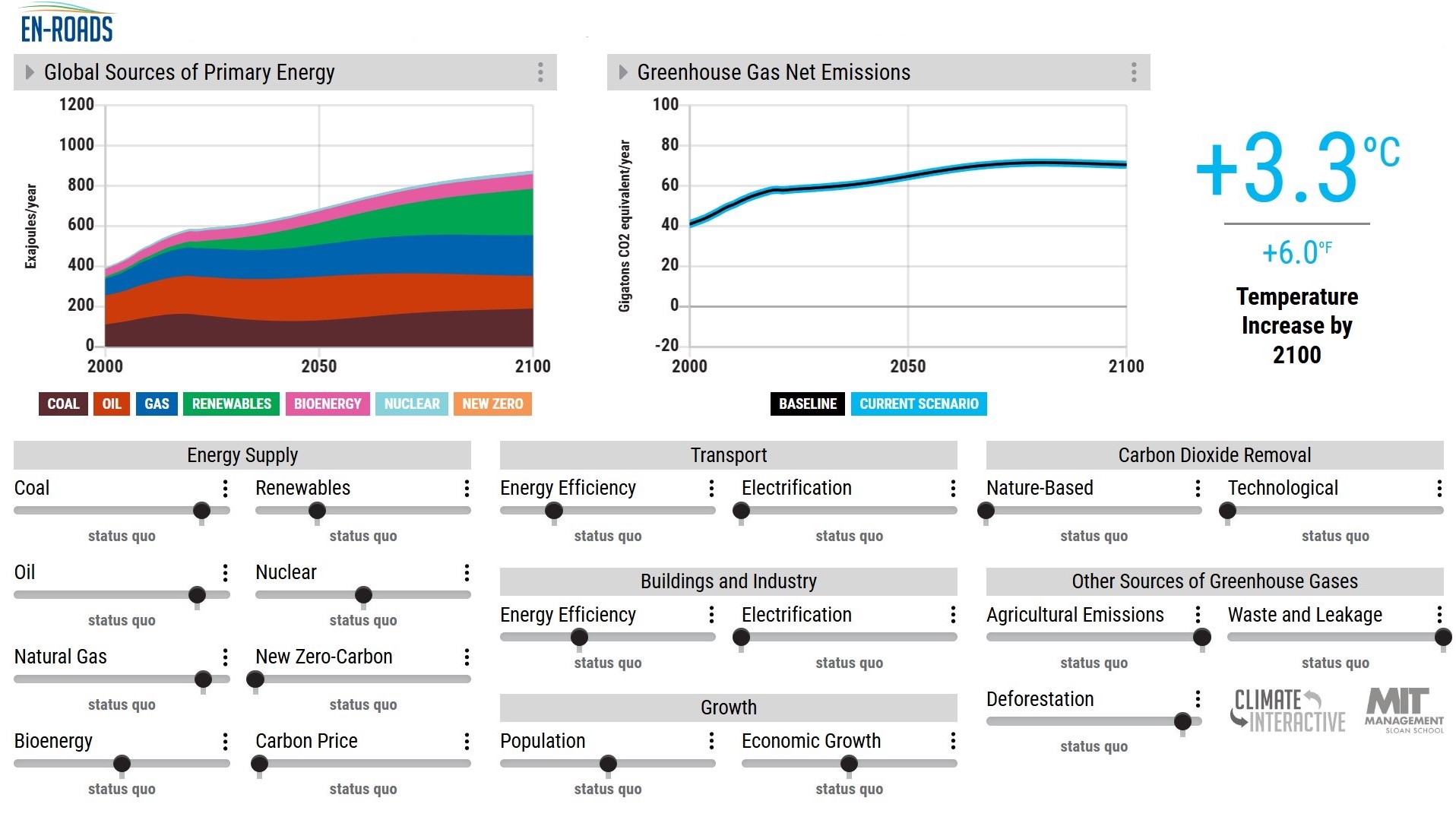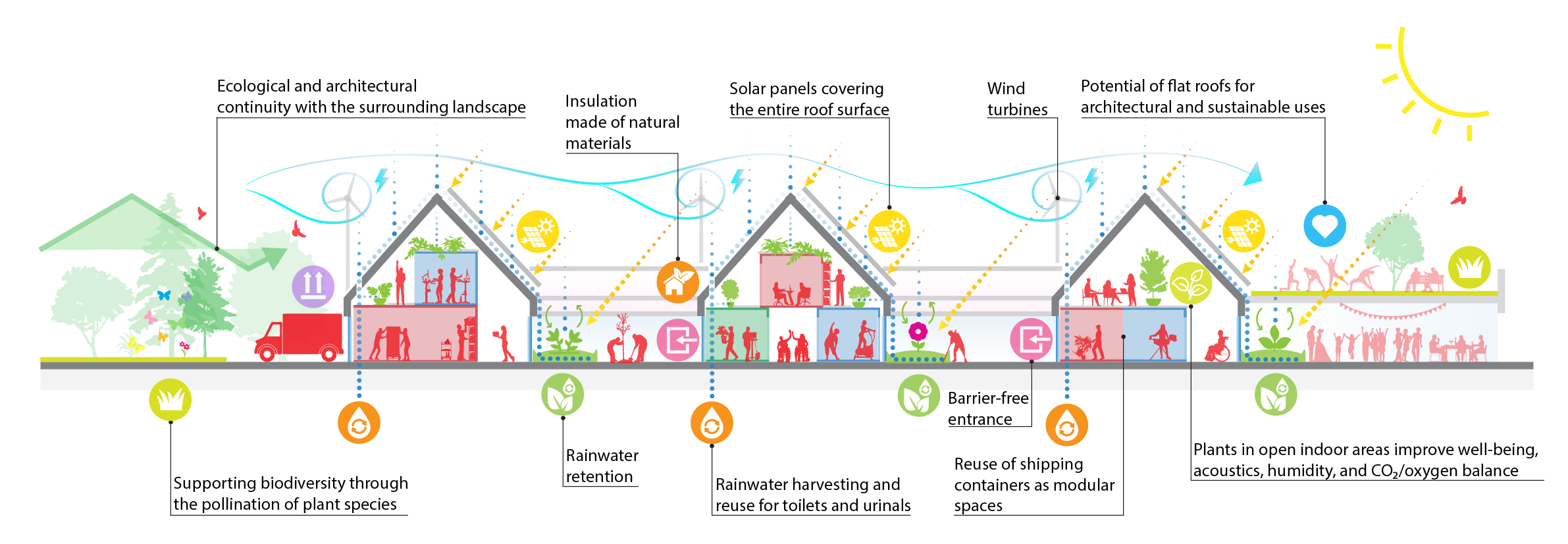Zero Emission Buildings
Architecture today is more than form. It’s ethics. It’s climate. It’s a chance.
The monitor displays a simple chart from the EN-ROADS simulator. The curve is rising. +3.3°C. These would be beautiful numbers if not for one thing this is not progress, but the temperature of our surrender. At the current pace of global development, the planet is on track to heat up by nearly four degrees by 2100. This is not a matter of opinion. This is a fact. It’s no longer about saving the situation. It’s about adapting to it, before the consequences become irreversible.  In the baseline scenario where the world continues along its current path without significant changes in construction, energy, or consumption, the forecast reaches +3.3 °C by the end of the century. This level doesn’t just mean heat; it means ecosystem instability, infrastructure collapse, as well as food and migration crises.
In the baseline scenario where the world continues along its current path without significant changes in construction, energy, or consumption, the forecast reaches +3.3 °C by the end of the century. This level doesn’t just mean heat; it means ecosystem instability, infrastructure collapse, as well as food and migration crises.
The world is already showing us where we’re headed:
- Rising temperatures — 2023 was the hottest year on record, 2024 pushed the boundaries of what was once considered a “normal” climate, and 2025 has already begun setting new temperature records across Europe, including absolute highs not seen since the early 20th century.
- Fires in Canada, Australia, Greece, the USA, and across Europe — forests are burning in places where flames had never reached before. Fire seasons are growing longer and hotter, spreading into new regions. Drought, heat, and dry winds create ideal conditions for fires to ignite and spread rapidly.
- Floods and droughts are two faces of the same climate destabilization. While rivers dry up in one region, they overflow in another. In 2024 alone, a catastrophic flood in Southern Europe claimed hundreds of lives — in areas where not long ago water rarely reached the curbs.
- Extreme heatwaves are making it impossible to study in schools, work outdoors, or even sleep at night.
- Traditional climate zones are shifting, and agriculture is struggling — one day drought, the next torrential rain, and sometimes both at once.
- Greenland and Antarctica are losing ice at rates that had previously been forecast for mid-century.
We are not on the brink of a climate catastrophe — we’re already in it. But still holding a cup of coffee, with our phones charging beside us for now. However, behind the façade of comfort, the same concrete that accounts for 40% of global CO₂ emissions is cracking.
The construction industry is one of the major contributors to climate change. Emissions from the production of cement, steel, and other building materials don’t disappear once construction is finished: carbon dioxide isn’t absorbed instantly — it breaks down slowly, circulates in the atmosphere, and continues to intensify the greenhouse effect the entire time. The average “lifespan” of such an emission is around 100 years. This means that a building constructed today will keep warming the climate throughout the lives of its creator’s great-grandchildren. We can no longer afford building as if the world isn’t changing. It is changing — rapidly and irreversibly. Every new building is a carbon footprint. Every new roof is a climate commitment. Architecture is no longer a “moment of form” — it has become a force of a long-term impact. And it is architecture that can — and must — become the first line of our defense.
Global anxiety is just a prologue. What matters is what each of us can do — especially those who literally design the future. Does this mean we shouldn’t build? No. It means we must build differently.
 An EN-ROADS scenario after increasing building efficiency, electrifying industry, refusing from coal, and strengthening nature-based solutions: temperature drops to +2.5 °C. Architecture and a construction industry become a part of effective climate action.
An EN-ROADS scenario after increasing building efficiency, electrifying industry, refusing from coal, and strengthening nature-based solutions: temperature drops to +2.5 °C. Architecture and a construction industry become a part of effective climate action.
Even without harsh restrictions or futuristic technologies, we can slow down global warming by nearly a full degree. All it takes is architecture that doesn’t create new problems — but solves the existing ones: efficient buildings, adaptive structures, smart energy systems, and respect for ecosystems.
ZEB (Zero Emission Buildings) — it's not a style, it's the minimum ethical standard of the future. These are buildings that not only consume less resorces, but leave almost nothing behind — neither in the air nor in the landscape. And if we want our cities to survive the 21st century, they must start changing today.
All of Europe is preparing for the shift: according to the EU Directive on the Energy Performance of Buildings (EPBD), starting in 2030, all new buildings must achieve zero emissions across their entire life cycle. For buildings owned or used by public authorities, the standard becomes mandatory as early as 2028. These are the new rules of the game in design — architects and engineers will no longer be tasked solely with designing, but with calculating and justifying the building’s carbon footprint — from materials to demolition.
This series of articles is not a manifesto — it’s a toolkit. We’ll show how simple yet relevant architectural strategies — from material recirculation to green façades — can serve as a foundation both for designing zero-emission buildings and for adapting them to climate impacts. As of today, it’s no longer about aesthetics. It’s about climate.
Infographic: Author — Henrykh Baltsevich. Based on original architectural research. Used with permission.
